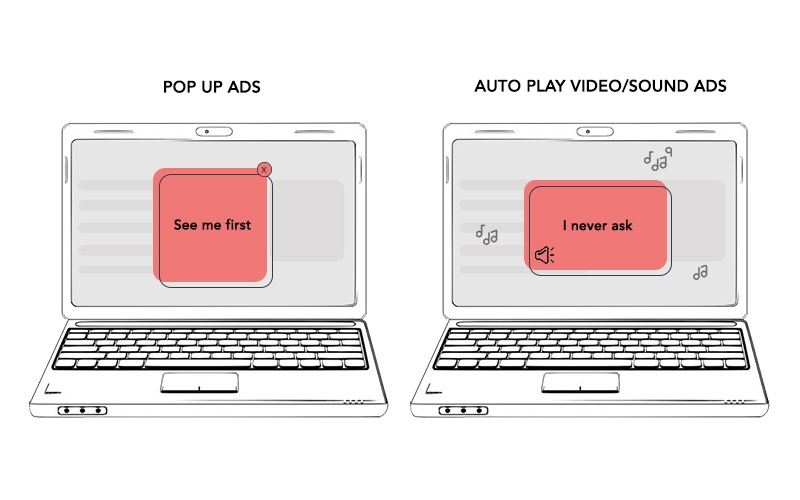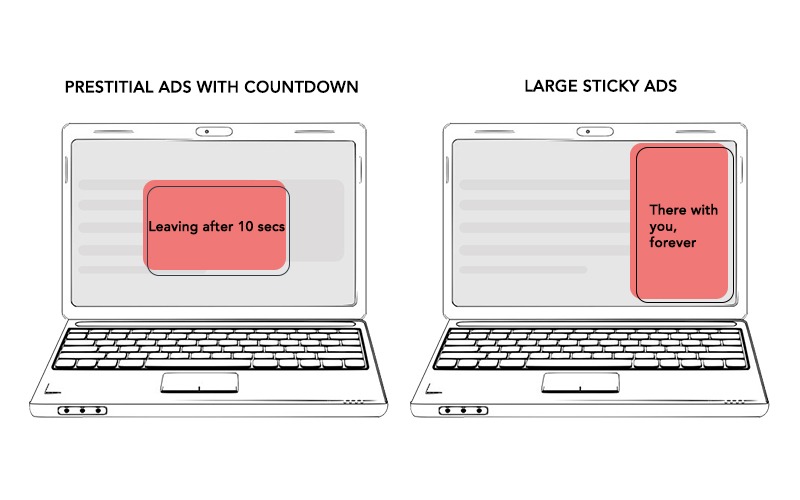Better Ads Standards is a framework designed to make online ads better by ranking them based on user preferences. Learn more about how it works.
Advertising is the internet’s currency. It is through ads that users are able to access valuable content, for free. However, with time, users are now starting to show their dissatisfaction with disruptive and intrusive ads.
According to Hubspot research, nearly 91% of users find ads more intrusive today than 2-3 years ago. 79% of users feel they are being tracked by retargeting ads. In addition, about 15% of users also say that some ads tricked them into clicking.
To counter this, reputed international trade associations and online media companies together formed the coalition for Better Ads and introduced Better Ads Standards. The concept is centered on understanding consumer preferences and addressing their expectations in the world of digital advertising.
What are Global Better Ads Standards?
Better Ads Standards is a framework created and introduced by the Coalition for Better Ads. The better ads standards google framework aims at refining users’ experience with both desktop and mobile-based ads.
Why Better Ads Standards?
One never-ending fight publishers face is winning against ad blockers. As per TheNextWeb, publishers lost about $22 billion of revenue to ad-blocking software in 2015. By 2017, the number of ad blocker users rose to 615 million users, compared to 198 million in 2015. Further, 83% of users said they‘d like to have an ad-blocking option on mobile devices.
Clearly, ad blockers have had a severe effect on publishers who are solely dependent on ad revenue for income. Also, increasing ad blocker adoption is a sign that something is seriously wrong with ads in their current state. But, there are ways publishers can detect adblockers and find a solution to not let them affect the ad revenue.
It is also well known that Google takes user experience seriously. The experts at Google agree that bad ad types can hurt a publisher’s ad revenue. Just like the coalition, Google prefers non-intrusive and well-thought out ad placements from publishers.
So on the good side, publishers are now able to know which ad types are the least preferred by users, thanks to the Better Ads Standards research. Eventually, the standards might prove useful for publishers in their fight against ad blockers.
How does Better Ads Work?
The coalition determines the lowest-ranking ad experiences which prompt the adoption of ad blockers amongst internet users. For this, their research identifies the least preferred ad types that disrupt experience, interrupt content, and slow down browsing.
Next, by testing all desktop and mobile-based ad format, the standards define which ad types are acceptable for consumers, and which are not. Once defined, the lowest-ranking ad types are recommended for removal by publishers and webmasters.
Introduced in March 2017, Better Ads Standards are primarily effective in North America and Europe. Since publication, the standards have been adopted and incorporated by many publishers in their ad practices.
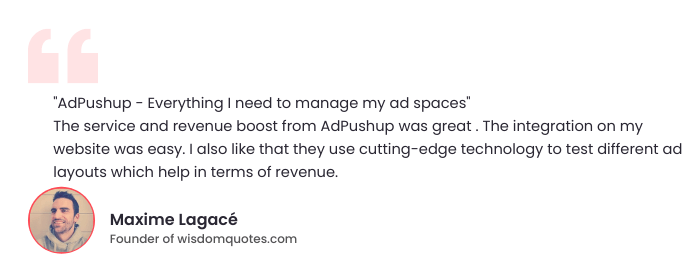
What Is The Need for Better Ads?
The coalition’s conceptualization of Better Ads Standards has been based on research and surveys that they conducted to gather real consumer insights and understand user preferences about online ads.
In the first phase, they surveyed over 25,000 North American and European internet users. Here, the users were asked about their problems and preferences on different types of online ads. This phase studied about 55 desktop-based and 49 mobile-based ad experiences.
In phase two, similar research was conducted to learn the problems and preferences of consumers in Asia, Latin America, and Africa. Consequently, both studies found similar consumer preferences on the most- and least-preferred ad types and experiences, thus creating the need for a framework like the Better Ads Standards.
Also, Better Ads Standards has always prioritized consumer preferences. Therefore, to reach a conclusion, a user-centric methodology was deployed. The researchers combined all the responses and created a ‘ranking system’ to rank ad experiences from best to worst.
Desktop-based ads that were found to be the most disruptive:
- Pop up ads
- Auto-playing videos with sound
- Prestitial ads with a countdown
- Large sticky ads
Mobile-based ads that were found to be the most disruptive:
- Pop-up ads
- Prestitial ads
- Mobile pages with more than 30% ad density
- Flashing animations
- Poststitial ads that require a countdown to dismiss
- Fullscreen scroll-over ads
- Large sticky ads
- Auto playing videos with sound
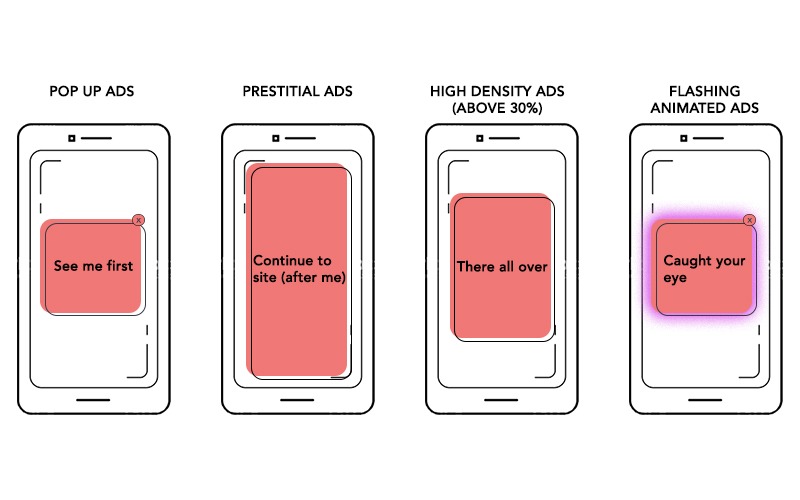
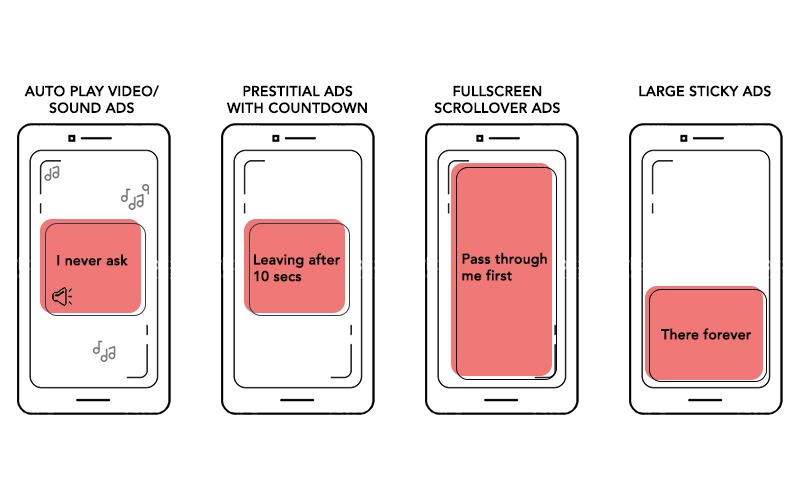
Based on the ranking, these ad types are the first on the list to be improved or removed. Of all types, pop-up ads and autoplay video ads with sound were the most despised. Some ad types were classified as ‘not all bad’ if they were used in the right manner, e.g., sticky ads.
Who are the Better Ads Standards Meant for?
From its publication in 2017, the Better Ads Standards have been effective in North America and Europe as stated above. In January 2019, the Coalition for Better Ads announced it plans to expand Better Ads Standards worldwide.
For publishers
The standards guide them on how to follow best ad practices and deliver better user experience to their audience. The coalition also runs a Better Ads Experience Program, inviting publishers to participate and get certification from Better Ads Standards for following the best practices.
For advertisers
Better Ads Standards empower them to develop and execute informed ad campaigns. Since the standards target publishers in the first place, advertisers get a clearer idea on: Which publisher is compliant, who follows good practices, and whom to work with.
For Ad Tech Platforms
Ad networks and ad exchanges are responsible for helping publishers run ads on their websites. Better ads Standards help these platforms develop new and improved ad offerings for publishers, and hence users.
The coalition said that it will review the desktop- and mobile-based ad practices of publishers outside of North America and Europe.
How Publishers Can Comply with Better Ads Standards?
Here’s how publishers can comply with better ads standards:
Conduct a Self-Review
Begin by conducting a thorough self-assessment of your website’s ad experience. Access the Google Ad Experience Report through your Google Search Console account.
Ad Experience Report Analysis
Utilize the Ad Experience Report to evaluate both your website’s desktop and mobile pages. This test will identify any instances of non-compliant ad experiences on your site.
Collaborate with Experts
Engage with your webmaster or AdOps specialist to address any identified issues promptly. They can assist in rectifying the problems and improving the overall ad experience on your website.
Re-submission for Validation
After making the necessary adjustments, re-submit your website for another check through the Ad Experience Report to ensure compliance with the Better Ads Standards.
Consider Certification
Lastly, publishers have the option to pursue certification through the Coalition’s Better Ads Experience Program. This certification helps advertisers identify websites that meet the Better Ads Standards requirements. As part of this program, you commit to not serving disruptive ad formats as outlined in the Better Ads Standards
Once done testing, publishers can submit their site for review and get notified via reports. In fact, according to Google, most sites with no pop-up ads or auto playing video ads with sound are most likely considered compliant with the Better Ads Standards.
Final Words
The coalition considers consumer preferences as their most valuable data. Till date, over 66,000 internet users from different geographies have participated in their research. Also, with the program in place, it has been certifying publishers who comply with the standards.
The coalition has also been educating non-participating publishers about the benefits of adopting Better Ads Standards. And in the future, it plans to continue to engage publishers via webinars and other outreach methods. On the ad tech side, six programmatic ad exchanges have already committed to serving only Better Ads Standards-compliant ads.
Despite all the facts on disruptive ads, surprisingly there are stats that also show the brighter side. 77% of users say they wish there was a way to apply ad filters on a website, instead of an ad blocker. This suggests that to some extent, users are open to reconsider their use of ad blockers. But of course, in exchange for a decent experience.
FAQs on Better Ads Standards
Better Ads Standards are based on extensive user research conducted by the Coalition on annoying and disruptive ad formats and experiences.
Consumers’ online advertising experiences will be improved by the Better Ads Standards. In the long run, publishers will benefit from such initiatives.
Leading media companies and ad industry trade associations formed the Coalition for Better Ads to develop standards to improve the ad experience globally. Among its members are Google, Facebook, Microsoft, News Corp, Group M, Admiral, and others.

Deepak has a keen eye for detail and a deep understanding of the ad tech landscape. Whether it’s through in-depth articles, thought-provoking insights, or compelling storytelling, he’s dedicated to helping people navigate the complex world of ad tech with the simplicity of his words.

